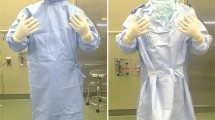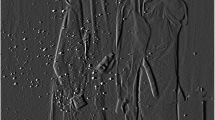Abstract
Introduction
Operating room air quality can be affected by several factors including temperature, humidity, and airborne particle burden. Our study examines the role of operating room (OR) size on air quality and airborne particle (ABP) count in primary total knee arthroplasty (TKA).
Materials and methods
We analyzed all primary, elective TKAs performed within two ORs measuring 278 sq ft. (small) and 501 sq ft. (large) at a single academic institution in the United States from April 2019 to June 2020. Intraoperative measurements of temperature, humidity, and ABP count were recorded. p values were calculated using t test for continuous variables and chi-square for categorical values.
Results
91 primary TKA cases were included in the study, with 21 (23.1%) in the small OR and 70 (76.9%) in the large OR. Between-groups comparisons revealed significant differences in relative humidity (small OR 38.5% ± 7.24% vs. large OR 44.4% ± 8.01%, p = 0.002). Significant percent decreases in ABP rates for particles measuring 2.5 μm (− 43.9%, p = 0.007) and 5.0 μm (− 69.0%, p = 0.0024) were found in the large OR. Total time spent in the OR was not significantly different between the two groups (small OR 153.09 ± 22.3 vs. large OR 173 ± 44.6, p = 0.05).
Conclusions
Although total time spent in the room did not differ between the large and small OR, there were significant differences in humidity and ABP rates for particles measuring 2.5 μm and 5.0 μm, suggesting the filtration system encounters less particle burden in larger rooms. Larger studies are required to determine the impact this may have on OR sterility and infection rates.
Similar content being viewed by others
Data availability
Data that support the findings of this study are available from the corresponding author, upon reasonable request.
References
Singh JA, Yu S, Chen L, Cleveland JD (2019) Rates of total joint replacement in the United States: future projections to 2020–2040 using the national inpatient sample. J Rheumatol 46(9):1134–1140. https://doi.org/10.3899/jrheum.170990
American Joint Replacement Registry (AJRR): 2022 Annual Report. Rosemont, IL: American Academy of Orthopaedic Surgeons (AAOS), 2022
Lidwell OM, Lowbury EJ, Whyte W, Blowers R, Stanley SJ, Lowe D (1983) Airborne contamination of wounds in joint replacement operations: the relationship to sepsis rates. J Hosp Infect 4(2):111–131. https://doi.org/10.1016/0195-6701(83)90041-5
Chauveaux D (2015) Preventing surgical-site infections: measures other than antibiotics. Orthop Traumatol Surg Res. 101(1 Suppl):S77-83. https://doi.org/10.1016/j.otsr.2014.07.028
Aerobiotix. Standards, Regulations and Guidelines Related to Hospital OR Air Quality. https://aerobiotix.com/wp-content/uploads/2018/05/Summary-of-Standards-Regulations-and-Guidelines-related-to-hospital-OR-air-quality.pdf
Alsved M, Civilis A, Ekolind P et al (2018) Temperature-controlled airflow ventilation in operating rooms compared with laminar airflow and turbulent mixed airflow. J Hosp Infect 98(2):181–190. https://doi.org/10.1016/j.jhin.2017.10.013
Andersson AE, Bergh I, Karlsson J, Eriksson BI, Nilsson K (2012) Traffic flow in the operating room: an explorative and descriptive study on air quality during orthopedic trauma implant surgery. Am J Infect Control 40(8):750–755. https://doi.org/10.1016/j.ajic.2011.09.015
Anis HK, Curtis GL, Klika AK et al (2020) In-room ultraviolet air filtration units reduce airborne particles during total joint arthroplasty. J Orthop Res. 38(2):431–437. https://doi.org/10.1002/jor.24453
Quraishi ZA, Blais FX, Sottile WS, Adler LM (1983) Movement of personnel and wound contamination. AORN J 38(1):146–147. https://doi.org/10.1016/s0001-2092(07)69557-x. (150–156)
Ritter MA, Olberding EM, Malinzak RA (2007) Ultraviolet lighting during orthopaedic surgery and the rate of infection. J Bone Jt Surg Am. 89(9):1935–1940. https://doi.org/10.2106/JBJS.F.01037
Perez P, Holloway J, Ehrenfeld L et al (2018) Door openings in the operating room are associated with increased environmental contamination. Am J Infect Control 46(8):954–956. https://doi.org/10.1016/j.ajic.2018.03.005
Sadrizadeh S, Pantelic J, Sherman M, Clark J, Abouali O (2018) Airborne particle dispersion to an operating room environment during sliding and hinged door opening. J Infect Public Health 11(5):631–635. https://doi.org/10.1016/j.jiph.2018.02.007
Teter J, Guajardo I, Al-Rammah T, Rosson G, Perl TM, Manahan M (2017) Assessment of operating room airflow using air particle counts and direct observation of door openings. Am J Infect Control 45(5):477–482. https://doi.org/10.1016/j.ajic.2016.12.018
Tsay MD, Tseng CC, Wu NX, Lai CY (2020) Size distribution and antibiotic-resistant characteristics of bacterial bioaerosol in intensive care unit before and during visits to patients. Environ Int 144:106024. https://doi.org/10.1016/j.envint.2020.106024
Funding
This research did not receive any specific grant from funding agencies in the public, commercial, or not-for-profit sectors.
Author information
Authors and Affiliations
Corresponding author
Ethics declarations
Conflict of interest
Royalties—Smith&Nephew. Speakers—Pacira Pharmaceuticals. Paid consultant—Smith&Nephew, Intelijoint, Horizon Pharmaceuticals. Stock—Intelijoint, Gauss Surgical, PSI, GENOVEL. Research support—Smith&Nephew, Intelijoint, Zimmer/Biomet. Other financial support—Smitha&Nephew. Medical publications editorial/governing board—JOA, Arthroplasty Today. Board member—AAHKS, AAOS, AJRR Steering Committee, PCORI.
Ethical approval
Not applicable—retrospective design.
Informed consent
Not applicable—retrospective design.
Additional information
Publisher's Note
Springer Nature remains neutral with regard to jurisdictional claims in published maps and institutional affiliations.
Rights and permissions
Springer Nature or its licensor (e.g. a society or other partner) holds exclusive rights to this article under a publishing agreement with the author(s) or other rightsholder(s); author self-archiving of the accepted manuscript version of this article is solely governed by the terms of such publishing agreement and applicable law.
About this article
Cite this article
Shen, M., Sicat, C.S., Schwarzkopf, R. et al. Larger operating rooms have better air quality than smaller rooms in primary total knee arthroplasty. Arch Orthop Trauma Surg 143, 6335–6338 (2023). https://doi.org/10.1007/s00402-023-04886-y
Received:
Accepted:
Published:
Issue Date:
DOI: https://doi.org/10.1007/s00402-023-04886-y




